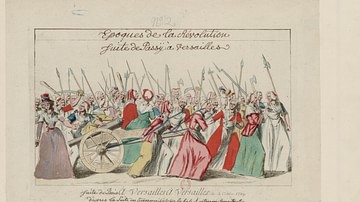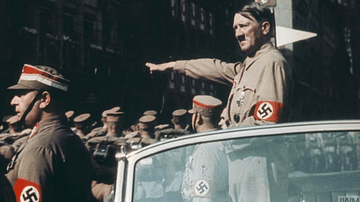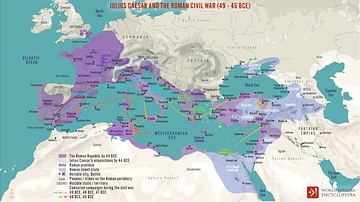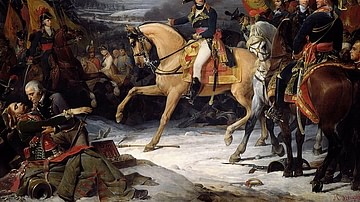
The Treaty of Versailles, signed in June 1919, was an agreement between the victors of the First World War (1914-18) which redivided parts of Europe and imposed reparations, armament limitations, and total blame for the war on Germany, one of the conflict's losers.
Although designed to guarantee a lasting peace, overturning the treaty's harsher points became a goal of successive German chancellors and then the Nazi leader Adolf Hitler (1889-1945) through the 1930s. Indeed, the ill-feeling towards the treaty was one of several reasons for the rise of national socialism and, ultimately, one of the causes of WWII (1939-45).
Aims of the Treaty
The First World War was fought between the Central Powers of Germany and Austria-Hungary (plus their allies) and the Triple Entente of Britain, France, and Russia (and their allies, which included Italy and the United States). Germany and Austria-Hungary lost the war and an armistice was signed on 11 November 1918. The victors, particularly Britain and France, now sought to impose such peace terms that Germany, in particular, would never again be able to threaten peace in Europe. The horrors of WWI, when 7 million people were killed and 21 million seriously injured, must never be repeated. There had been tremendous material costs, too. According to the historian F. McDonough, "the total estimated cost of the war has been put at £260,000 million" (43).
The victors first wanted an official recognition from Germany that it had started the war. Secondly, they wanted to be directly compensated by Germany for some of the material costs of the conflict by extracting hefty reparation payments and redistributing some German territory and all of its colonies. Germany's industry remained intact throughout the war, and the victors were wary of its ability to rebuild. To ensure the German armed forces could not wage war in the future, severe limitations were imposed on the country's military capabilities. The victors did not want to completely destroy Germany since it could remain a valuable market for their exports, however, most historians recognise that the Allies may have gone too far with their demands and, in the end, only pushed Germany towards the very destination they had hoped to avoid, another world war. The other losing states of WWI: Austria, Hungary, Bulgaria, and Turkey would be dealt with in separate, equally controversial treaties.

The Paris Peace Conference
The Treaty of Versailles was signed in the Hall of Mirrors in the Palace of Versailles outside Paris on 28 June 1919. Representatives from France, Britain, the United States, and Italy, plus 28 other nations, had convened at the Paris Peace Conference, held from 12 January 1919. The delegates had taken over five months to thrash out their terms and decide on what the new Europe should look like now that several royal dynasties had been swept away and their empires left in tatters. Proceedings were dominated by the 'Council of Four': British Prime Minister David Lloyd George (1863-1945), French Prime Minister French Georges Clemenceau (1841-1929), US President Woodrow Wilson (1856-1924), and Italian Prime Minister Vittorio Orlando (1860-1952). There is something of a myth that Clemenceau was responsible above all others for the harsher elements of the treaty, but, in fact, he fully realised that too harsh a settlement would be counterproductive to France's interests and create lasting resentment. He remarked: "every effort must be made to be just towards the Germans" (McDonough, 54). Of course, the French and German interpretation of justice was not entirely the same.
The USSR, then seen as a rogue revolutionary state that had unlawfully deposed its ruler, Tsar Nicholas II in the Revolution of 1917 and who had prematurely pulled out of the war, was not invited to Paris. Germany was only invited to the closing stages of the conference and then only in order to read the terms of its surrender and sign the treaty. The German delegates had been given only three weeks to discuss amongst themselves and suggest any minor changes, and then just one week to sign the final draft. With an Allied army occupying the Rhineland and a naval blockade in place, the stark reality for Germany was that a resumption of the war was the only alternative to signing the treaty.
The main points of the Treaty of Versailles include:
- Germany had to accept full responsibility for WWI
- Germany had to pay reparations to France, Britain, and Belgium
- France was given back the regions of Alsace and Lorraine
- The coal-rich Saar area of Germany was taken out of German control
- Poland was given the industrial region of Upper Silesia and a corridor to the Baltic Sea
- Danzig (Gdańsk) was removed from German control
- Germany lost all of its colonies
- The Rhineland was to be demilitarised
- A limit of 100,000 men was put on Germany's army.
- Germany could not build tanks, aircraft, submarines, or battleships
- A new international body of cooperation was to be created, the League of Nations

The Guilt Clause
The Treaty of Versailles, specifically recorded in Article 231, insisted that not only had Germany and its ally Austria-Hungary deliberately and with premeditation started a global conflict but they had also deliberately resisted all efforts by the Allies to avoid one. Many Germans viewed this 'guilt clause', as it became known, and the peace terms in general, as highly dishonourable. Indeed, the German government went into tremendous trouble during the interwar years to persuade other nations it had not been the guilty party, releasing nearly 16,000 official documents. In some measure, these endeavours were successful as, by the 1930s, a general consensus had arisen that WWI had been the collective responsibility of everyone involved. At the time of the Treaty of Versailles, though, the guilt clause was a major justification for the second step: reparations.
Reparations
France and Belgium were particularly keen to recoup some of the tremendous costs of the war: damage to property, infrastructures like roads and train lines, agriculture, machinery, shipping, and the debts accumulated in buying weapons. Amongst the victors, only the US was not in debt after the conflict. Industrial production in Europe was 30% lower than before the war, world trade was stagnant, and inflation dangerously high. A massive and regular cash injection paid for by Germany would give a much-welcome boost to the victors' economies. The mood of ordinary people, and certainly the popular press, in the victor countries was to make Germany pay heavily for the chaos. As one newspaper headline in Britain read: "Squeeze the German lemon till the pips squeak" (McDonough, 47). The first squeezing was to seize all Germany's financial assets and currencies held abroad. The question then remained just how much to squeeze in the coming years in terms of regular reparation payments.
The reality was that Germany could remain an important market for exports for the victors if not crushed economically. (It is interesting to note that amongst the British delegation in Paris was the economist John Maynard Keynes, 1883-1946, who called for lenient reparations). In addition, the British had suffered much less material damage in the war than France and were mostly interested in curbing Germany's military power, with the consequence that imposing heavy reparations was much less of a priority.

The Treaty of Versailles established the principle of German reparations, but not the details. The lack of precision concerning reparations led to much bitter negotiating thereafter, and several defaults on payments. Not until 1921 did a Reparations Committee fix the sum at £6,600 million. Payments were expected every year for the next six decades, first with a hefty downpayment in gold and then, if cash was not available, in useful goods like coal, livestock, timber, and ships. Germany frequently paid less than it was supposed to pay. In 1929, Germany's reparations were formally reduced as more US loans were negotiated. In 1932, the reparations were cancelled altogether. The reparations problem highlights the overall weakness of the Treaty of Versailles: most of its points relied on Germany volunteering to adhere to them. The practical task of enforcing the terms proved beyond the capabilities of the victors.
Redrawing Germany's Frontiers
The treaty removed much sought-after slices from Germany's border regions. France received back Alsace and Lorraine (they had lost these German-speaking regions in 1871 after defeat in the Franco-Prussian War), while Belgium and Denmark also got a few slithers of new land, Eupen-Malmedy and Northern Schleswig, respectively. The coal-rich Saar region was given to the League of Nations to manage with a plebiscite promised at an unspecified future date (when one was finally held in 1935, 90% voted to rejoin Germany). In another attempt to keep Germanic peoples separate, Germany was forbidden from ever uniting with Austria. The choicest cut, perhaps, was left for Poland which gained the industrialised region of Upper Silesia (handy to reduce the likelihood of German rearmament, thought the victors) and a 'Polish corridor' to the Baltic Sea. The corridor had a Polish majority, but the unfortunate result of this strip to the seaside was that it entirely cut off East Prussia from the rest of Germany. Danzig, which had a population that was 90% German, was made an autonomous Free City controlled by the League of Nations, but with its foreign policy and customs arrangements governed by Poland. The corridor and Danzig were probably the most resented of all the victors' geographical reshuffles.
Further afield, Germany lost all of its pre-war colonies, now to be governed by the League of Nations as 'mandated territories', although in reality, they were taken over by individual victor states. Germany's African colonies, like Togoland, Tanganyika, the Cameroons, and German South West Africa, in practice, came under British, French, Belgian, or South African rule. Shandong (then called Shantung), the port in northeast China, had been under German rule but was now given to Japan causing lasting resentment by the Chinese government, which wanted it, too. A handful of Pacific islands were distributed to Japan, New Zealand, and Australia. In all, these lost pieces made up a sizeable chunk of pre-war German territory, around 13%. In those lost territories was around 10% of Germany's pre-war population.

Armament Controls
In order to create a safe buffer zone between France and Germany, the Rhineland was demilitarised, that is fortifications and troops were prohibited there. Britain was particularly keen to keep Germany's armed forces as small as possible and so reduce any threat to the British Empire. The Versailles treaty imposed a 100,000-man limit on Germany's army while its navy could have no more than 36 ships and was similarly restricted in personnel. Conscription was not permitted. Germany could not possess tanks, heavy artillery, aircraft, battleships, or submarines. Essentially allowed only the bare minimum to protect its borders, Germany's army was now comparable to that of Greece, in other words, no threat at all to Britain, France, or any other major power.
The League of Nations
The idea of an international body that could somehow guarantee that future territorial and other disputes between countries did not lead to all-out war was promoted above all by Woodrow Wilson. The US president had come up with 14 points for a new world back in 1918. The president identified certain causes of the war he wanted never to replicate: self-interested and secretive diplomacy, the repression of minority groups within empires and larger states, and autocratic regimes ignoring their own people's wishes. A new international organization was required that would eradicate these three diseases of world diplomacy and champion instead democracy, self-determination, and openness (although his emphasis on self-determination clearly did not apply to WWI's losers). This bright new beacon of hope was to be called the League of Nations.
Unfortunately, any chances of the League having any real power against errant nations were severely curtailed when, due to domestic isolationist politics, the United States, the most powerful country in the world, decided not to become a member. Who was in and who was out became a defining feature of the League. Germany only joined in 1926 and left again in 1933. Not coincidentally, the USSR saw fit to join the year after. Italy and Japan, both pursuing an aggressive imperialistic foreign policy, challenged the League into action in the interwar years, and none was forthcoming, at least of any importance. The lack of reaction from the League to international aggression was duly noted by Hitler.
The League did achieve some progress in promoting welfare and established the usefulness of a debating chamber for non-military international issues of all kinds, and so it was, despite its difficulties, a forerunner of today's United Nations.
Impact & Assessment
The Versailles settlement left an imbalance in power across Europe. Unlike so many treaties after so many other wars, Germany as a losing country was still "geographically and economically largely intact and preserved her political unity and her potential strength as a great nation" (Shirer, 58). The treaty, and other similar ones, had established nine new countries in Eastern Europe, and this was a recipe for instability since all of them disputed their borders, and many contained large minority groups who claimed to be part of another country. Germany, Italy, and the USSR, when once powerful again, looked upon these fledgling states with imperialist envy. Italy had been largely ignored at the Paris conference despite ending on the winning side. Italian ambitions to control the port of Fiume were dashed at Versailles causing lasting resentment (the Italian delegation walked out of the conference over the issue). Fiume became a point of national honour that the fascist leader Benito Mussolini (1883-1945) used to further his grip on power in 1922.
In Germany, the resentment was immediate and enduring. People, and not just those of the far-right, protested in the streets. The treaty was widely called a 'dictated peace' in the press, and the signatories of the treaty were immediately branded 'the criminals of 1919', including the German representatives. The new German President Friedrich Ebert (1871-1925) described the terms as "unrealisable and unbearable" (McDonough, 2012, 7). This resentment was fuelled by the myth that the German people had been let down in WWI by the high command of their army which had 'stabbed them in the back', otherwise, they might have won the war, many thought. In addition, the treaty was not what people had thought Woodrow Wilson and his overtures of self-determination would permit to happen. Consequently, the terms of the Treaty of Versailles came as a great shock to many ordinary Germans.

The ills of the new German state, the Weimar Republic (1918-33), were repeatedly blamed on the treaty, a millstone around the neck of Germany that obstructed any chances of growth and prosperity. Various German chancellors tried to weaken the terms of the treaty. Adolf Hitler persistently stoked up nationalist feelings using the treaty. In his book Mein Kampf, published in 1925, Hitler had the abolition of the Treaty of Versailles as the number one point in his list of foreign policy objectives when he achieved his dream of becoming leader of Germany. In speeches and interviews to the foreign press Hitler variously described the treaty as an "instrument of boundless repression" (McDonough, 65) and "the penitentiary of Versailles" (Range, 195). The inglorious humiliation of the Treaty of Versailles was one of several reasons why the Nazis gained popularity and were able to legitimately take power in Germany from 1933. Hitler formally repudiated the treaty in March 1935, although he had already been breaking the limitation rules about armed forces and armaments for some time. Hitler was then particularly keen to get back the lost German territories and so he started a cycle of land-grabs until the invasion of Poland in 1939 led to WWII breaking out on 3 September.
Hindsight is a wonderful thing, but one British delegate who had been at the Paris Peace Conference, writing in 1939, was not alone in recognising that the terms of the Treaty of Versailles had been, in the end, highly counterproductive:
The historian, with every justification, will come to the conclusion that we were very stupid men. I think we were…the treaties imposed were neither just nor wise…We had accepted a system for others which, when it came to practice, we should refuse to apply to ourselves.
(McDonough)
The world was not helped by the Great Depression of 1929 and the consequent dramatic economic and social problems, which put great stress on traditional political institutions everywhere. In light of these events, the weaknesses of the Treaty of Versailles, which might otherwise not have been so serious, began to fracture Europe once again. Some historians have pointed out, too, that rather than the treaty itself, it was the lack of unity amongst the victors of WWI and their distinct unwillingness to enforce its terms that caused the international crises of the 1930s. One way or another, though, the Treaty of Versailles was certainly a significant contributor, albeit not the only one, to the chaos and horrors of the Second World War.






